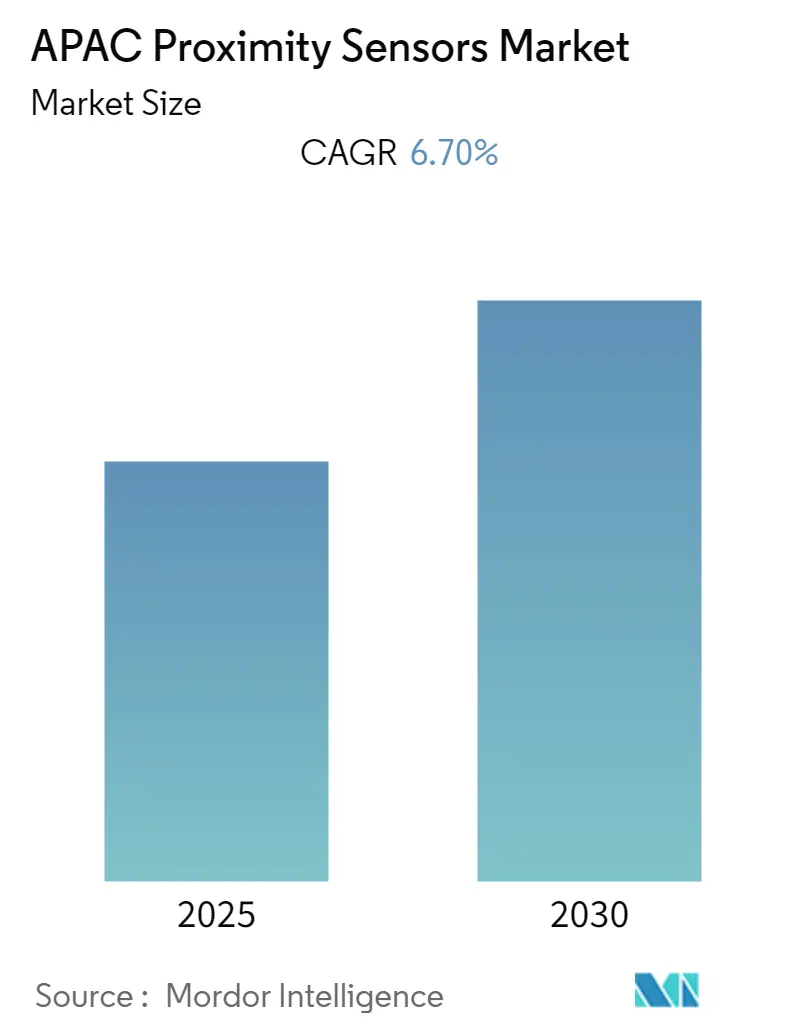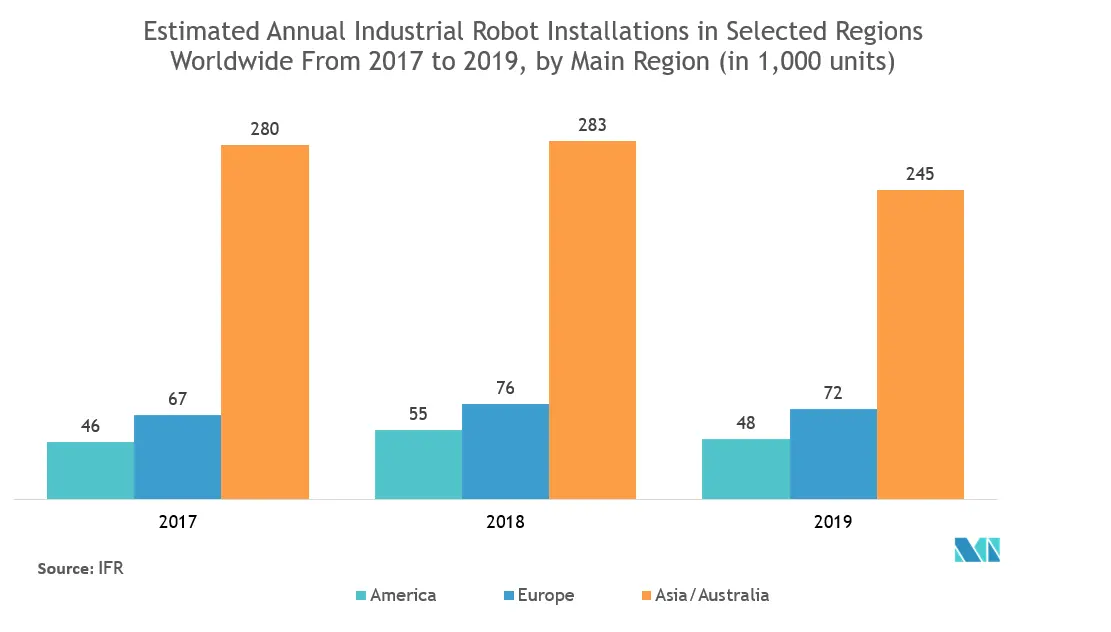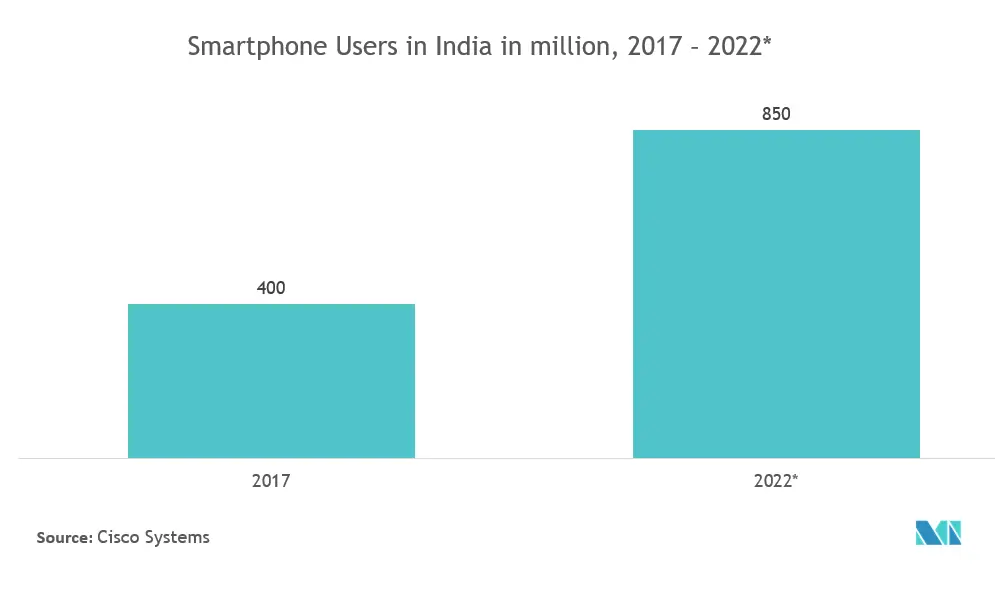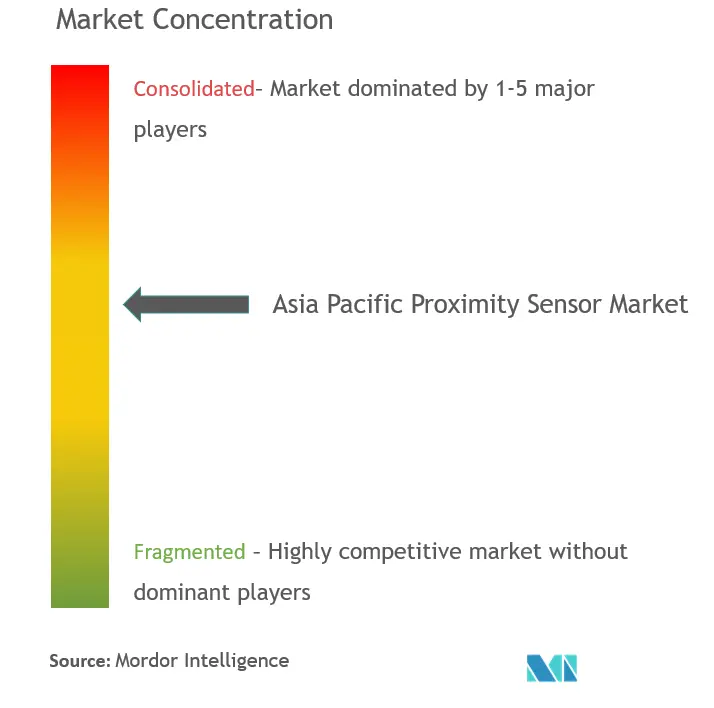
APAC Proximity Sensors Market Analysis by Mordor Intelligence
The APAC Proximity Sensors Market is expected to register a CAGR of 6.7% during the forecast period.
- Rapid industrialization and economic developments in the Asia-Pacific region are attracting investors in countries, such as China and India. Moreover, an increase in smartphone production, vehicle production, and sales are fueling the market for automotive proximity sensors in the region.
- The significant presence in the semiconductor industry and South Korea's efforts to increase semiconductor, electronics, and components manufacturing are estimated to contribute to the market share of the proximity sensors in the country. According to Korea International Trade Association, South Korea imported semiconductor manufacturing equipment worth a total of USD 1.212 billion from Japan in the first five months of 2019.
- The region has been witnessing numerous developments in the proximity sensors for the deployment in the consumer electronics. For instance, Elliptic Labs' AI Virtual Proximity Sensor TM, INNER BEAUTY, has been deployed in Xiaomi Redmi K30 smartphone models, the first phones Redmi series to feature Elliptic Labs' technology. The sensor enables OEMs to deliver phones with a simple, full-screen design.
- Furthermore, various government programs, such as the Made in China 2025 plan, are promoting the use of R&D in factory automation and technologies and their investments. Also, as most of the automation equipment is imported from Germany and Japan, the 'Made in China' initiative aims to expand the country's domestic production of automation hardware and equipment.
- The industry's shift toward the production of connected and ASAS-assisted vehicles in South Korea is driving the growth. In 2018, the South Korean government mandated AEB from January 2019 in all new passenger vehicles. These mandates will drive the growth of the ADAS market in the near future, which would further boost the market for proximity sensors.
APAC Proximity Sensors Market Trends and Insights
Growing Adoption of Industrial Robots in Asian Countries is Expected to Drive the Market
- Proximity sensors offer accurate and repeatable operations to achieve efficient production. An increase in the automation of complex production systems has led to the need for components that can offer critical data concerning the production process. Thus, these are currently used in industrial robots to carry the repetitive and tedious work and is expected to drive the studied market.
- Industry 4.0, the newest industrial revolution, has fueled the development of new technologies, like robots, which have enabled industries to use them to streamline various processes, increase efficiency, and eliminate errors. Proximity sensors are used in robots for automobiles manufacturing to trace the distance in various applications.
- According to the IFR World Robotics Report 2020, Asia remains the strongest market for industrial robots as operational stock for the region´s largest adopter China rose by 21% and reached about 783,000 units in 2019. Japan ranks second with about 355,000 units which are increased by 12% and India a new record of about 26,300 units rose by 15%. Within five years, India has doubled the number of industrial robots operating in the country´s factories.
- In China, adoption of industrial robots also is increasing due to the rise in labor costs, global price competition, and requirement for product quality. Thus, the county aims to establish its intelligent manufacturing system and complete the key industries’ transformation by 2025, which would further require deployment of proximity sensors over the entire facility.
- The companies in the market are developing advanced proximity sensors in order to meet the growing demand in IoT devices. For instance, Omron Corporation, in 2019, launched a total of 2,512 models of its DC 3-Wire E2E NEXT Series Proximity Sensors, which have the longest sensing distances and are equipped with IoT features. These sensors minimize risks of sudden facility stoppages, discover signs that warn of such stoppages, and notify users through the network. They also improve facility operation rates by preventing facility stoppages and minimizing facility downtime.

Increasing Investment on Consumer Electronics is Expected to Drive the Market
- The Asia Pacific region is an electronics hub with millions of electronic devices being made every year for consumption in the region itself and also for exporting to other places. This high production of electronic devices and components significantly contributes to the market share of the market studied.
- Furthermore, the region is a highest producer and consumer of smartphones. The Chinese market consumes the majority of the global smartphone production, and it is home of local brands that are becoming increasingly global. This is majorly contributing to the Asia-Pacific’s share, globally.
- Smartphones and wearables, such as smartwatches and fitness trackers, are experiencing high growth in Asian countries. This is expected to drive the demand for proximity sensors over the forecast period. According to Fitbit, in 2018, the company sold around 14 million units of its smart fitness devices.
- For instance, in smartphones, a proximity sensor detects how close the phone is to an outside object, like an ear. This sensing is done to minimize display power consumption on a call by turning off the backlight. It also disables the touch screen to avoid accidental touches by the cheek.
- According to Cisco’s Visual Networking Index smartphone users in India are expected to double by 2022 to 829 million from 404.1 million in 2017. The index predicted that 60% of the Indian population which is 840 million will be internet users by 2022, up from 27% of the population (357 million) in 2017. Also, smart devices will propel India’s per capita traffic consumption to nearly 14 gigabytes by 2022 from 2.4 gigabytes in 2017.

Competitive Landscape
The Asia Pacific proximity sensor market is concentrated due to higher initial investments. It is dominated by a few major players like Omron Corporation, Keyence Corporation, TDK Corporation, Panasonic Corporation, and Delta Electronics Inc. These significant players, with a prominent share in the market, are focusing on expanding their customer base across foreign countries. These companies are leveraging strategic collaborative initiatives to increase their market share and increase their profitability. However, with technological advancements and product innovations, mid-size to smaller companies are growing their market presence by securing new contracts and tapping new markets.
- June 2020 - TDK Corporation announced that InvenSense Inc., a TDK Group Company, and Arrow Electronics, Inc. have extended their global distribution agreement to supply InvenSense products. Under the new agreement, Arrow extends its distribution of InvenSense's complete portfolio of micro-electrical mechanical system (MEMS) based products to customers in the Americas, Middle East, Africa, and Asia-Pacific regions.
- March 2020 - Omron Corporation released the E2EW Series metal face proximity sensors that are designed to minimize the downtime. These highly durable, metal face proximity sensors boast the longest sensing range in their category to date, and they have been optimized to withstand the harsh conditions of typical automotive welding processes with a fluororesin coating that provides increased spatter resistance.
APAC Proximity Sensors Industry Leaders
Panasonic Corporation
Delta Electronics Inc.
Keyence Corporation
TDK Corporation
Autonics Corporation
- *Disclaimer: Major Players sorted in no particular order

APAC Proximity Sensors Market Report Scope
A proximity sensor is a sensor that is able to detect the presence of nearby objects without any physical contact. For sensing objects, this sensor radiates or emits a beam of electromagnetic radiation, usually in the form of infrared light, and detects the reflection to determine the object's proximity or distance from the sensor. A proximity sensor often emits an electromagnetic field or a beam of electromagnetic radiation (for instance, infrared) and detects changes in the field or return signal.
| Inductive |
| Capacitive |
| Photoelectric |
| Magnetic |
| Aerospace and Defense |
| Automotive |
| Industrial |
| Consumer Electronics |
| Food and Beverage |
| Other End-user Verticals |
| China |
| South Korea |
| Japan |
| India |
| Rest of Asia Pacific |
| Technology | Inductive |
| Capacitive | |
| Photoelectric | |
| Magnetic | |
| End-User | Aerospace and Defense |
| Automotive | |
| Industrial | |
| Consumer Electronics | |
| Food and Beverage | |
| Other End-user Verticals | |
| Country | China |
| South Korea | |
| Japan | |
| India | |
| Rest of Asia Pacific |
Key Questions Answered in the Report
What is the current APAC Proximity Sensors Market size?
The APAC Proximity Sensors Market is projected to register a CAGR of 6.7% during the forecast period (2025-2030)
Who are the key players in APAC Proximity Sensors Market?
Panasonic Corporation, Delta Electronics Inc., Keyence Corporation, TDK Corporation and Autonics Corporation are the major companies operating in the APAC Proximity Sensors Market.
What years does this APAC Proximity Sensors Market cover?
The report covers the APAC Proximity Sensors Market historical market size for years: 2019, 2020, 2021, 2022, 2023 and 2024. The report also forecasts the APAC Proximity Sensors Market size for years: 2025, 2026, 2027, 2028, 2029 and 2030.
Page last updated on:
APAC Proximity Sensors Market Report
Statistics for the 2025 APAC Proximity Sensors market share, size and revenue growth rate, created by Mordor Intelligence™ Industry Reports. APAC Proximity Sensors analysis includes a market forecast outlook for 2025 to 2030 and historical overview. Get a sample of this industry analysis as a free report PDF download.



